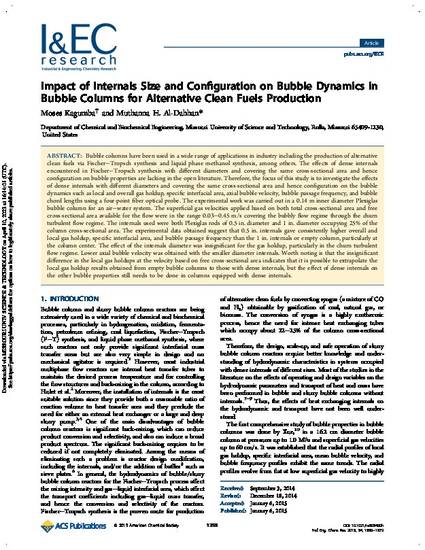
Bubble Columns Have Been Used in a Wide Range of Applications in Industry Including the Production of Alternative Clean Fuels Via Fischer-Tropsch Synthesis and Liquid Phase Methanol Synthesis, among Others. the Effects of Dense Internals Encountered in Fischer-Tropsch Synthesis with Different Diameters and Covering the Same Cross-Sectional Area and Hence Configuration on Bubble Properties Are Lacking in the Open Literature. Therefore, the Focus of This Study is to Investigate the Effects of Dense Internals with Different Diameters and Covering the Same Cross-Sectional Area and Hence Configuration on the Bubble Dynamics Such as Local and overall Gas Holdup, Specific Interfacial Area, Axial Bubble Velocity, Bubble Passage Frequency, and Bubble Chord Lengths using a Four-Point Fiber Optical Probe. the Experimental Work Was Carried Out in a 0.14 M Inner Diameter Plexiglas Bubble Column for an Air-Water System. the Superficial Gas Velocities Applied based on Both Total Cross-Sectional Area and Free Cross-Sectional Area Available for the Flow Were in the Range 0.03-0.45 M/s Covering the Bubbly Flow Regime through the Churn Turbulent Flow Regime. the Internals Used Were Both Plexiglas Rods of 0.5 In. Diameter and 1 In. Diameter Occupying 25% of the Column Cross-Sectional Area. the Experimental Data Obtained Suggest that 0.5 In. Internals Gave Consistently Higher overall and Local Gas Holdup, Specific Interfacial Area, and Bubble Passage Frequency Than the 1 In. Internals or Empty Column, particularly at the Column Center. the Effect of the Internals Diameter Was Insignificant for the Gas Holdup, particularly in the Churn Turbulent Flow Regime. Lower Axial Bubble Velocity Was Obtained with the Smaller Diameter Internals. Worth Noting is that the Insignificant Difference in the Local Gas Holdups at the Velocity based on Free Cross-Sectional Area Indicates that It is Possible to Extrapolate the Local Gas Holdup Results Obtained from Empty Bubble Columns to Those with Dense Internals, But the Effect of Dense Internals on the Other Bubble Properties Still Needs to Be Done in Columns Equipped with Dense Internals.
Available at: http://works.bepress.com/muthanna-al-dahhan/214/
